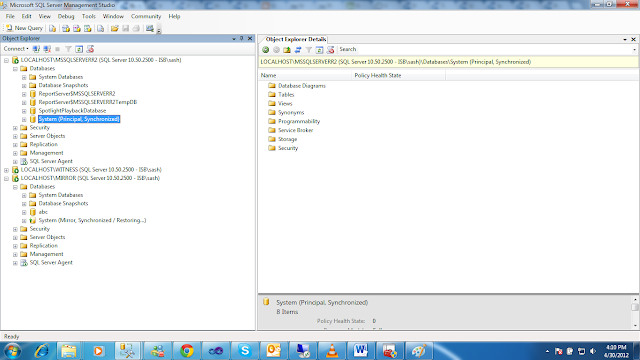Fail-over techniques in database mirroring. There are different techniques for database mirroring.
- Automatic fail over
- Manual fail over
- Forced fail over
Manual failover disconnects the clients
from the database and reverses the roles of the partners. Only high-safety mode
supports manual fail over.
During a manual failover, the principal
and mirror server roles are swapped for the database on which the failover
occurs. The mirror database becomes the principal database and the principal
database becomes the mirror. For example, the following table shows the how a
manual failover swaps the roles of two mirroring partners: System
The following figure
illustrates an instance of using manual failover to maintain database
availability while you upgrade a database server instance. When the upgrade is
completed, an administrator may optionally fail over back to the original
server instance. This is useful when the administrator wants to stop the
mirroring session and use the mirror server elsewhere. In this way, a single
server instance can be used repeatedly when updating a series of database
server instances.
1.
The principal server disconnects clients from the principal
database, sends the tail of the log to the mirror server, and, in preparation
for switching to the mirror role, sets the mirroring state to SYNCHRONIZING.
2.
The mirror server records the log sequence number (LSN) of the
last log record received from the principal as the failover LSN.
3.
If any log is waiting in the redo queue, the mirror server
finishes rolling forward the mirror database. The amount of time required
depends on the speed of the system, the recent workload, and the amount of log
in the redo queue. For a synchronous operating mode, the failover time can be
regulated by limiting the size of the redo queue. However, this can cause the
principal server to slow down to allow the mirror server to keep up.
4.
The mirror server becomes the new principal server, and the former
principal server becomes the new mirror server.
5.
The new principal server rolls back any uncommitted transactions
and brings its copy of the database online as the principal database.
6.
The former principal takes on the mirror role, and the former
principal database becomes the mirror database. The new mirror server quickly
resynchronizes the new mirror database with the new principal database.
Manual fail-Over
through Query
When the mirrored database is synchronized,
the database owner can initiate manual failover to the mirror server. Manual
failover can be initiated only from the principal server.
1.
Connect to the principal server.
2.
Set the database context to the master database:
3.
Issue the following statement on the principal server:
This
initiates an immediate transition of the mirror server to the principal role.


































